
incubator-kie-optaplanner
AI constraint solver in Java to optimize the vehicle routing problem, employee rostering, task assignment, maintenance scheduling, conference scheduling and other planning problems.
Stars: 3360
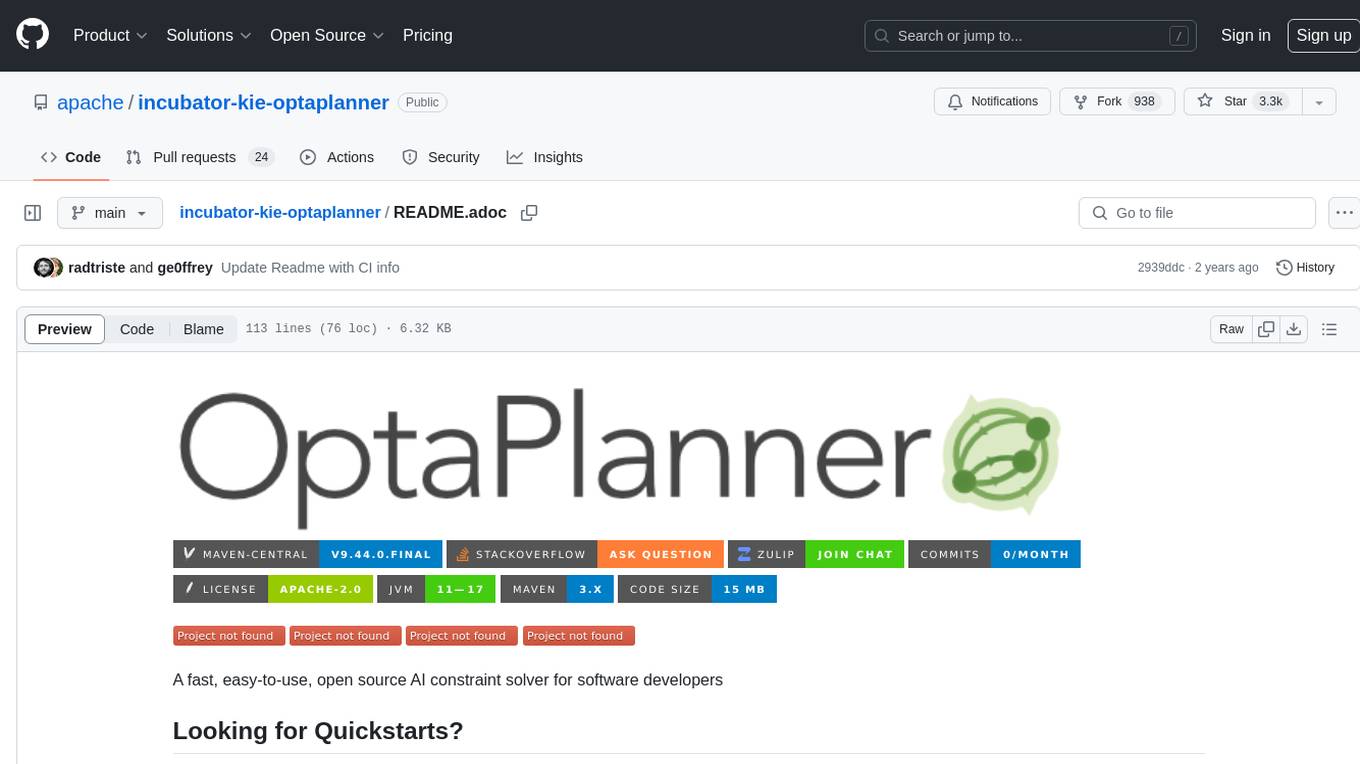
A fast, easy-to-use, open source AI constraint solver for software developers. OptaPlanner is a powerful tool that helps developers solve complex optimization problems by providing a constraint satisfaction solver. It allows users to model and solve planning and scheduling problems efficiently, improving decision-making processes and resource allocation. With OptaPlanner, developers can easily integrate optimization capabilities into their applications, leading to better performance and cost-effectiveness.
README:
//// Licensed to the Apache Software Foundation (ASF) under one or more contributor license agreements. See the NOTICE file distributed with this work for additional information regarding copyright ownership. The ASF licenses this file to you under the Apache License, Version 2.0 (the "License"); you may not use this file except in compliance with the License. You may obtain a copy of the License at
http://www.apache.org/licenses/LICENSE-2.0
Unless required by applicable law or agreed to in writing, software distributed under the License is distributed on an "AS IS" BASIS, WITHOUT WARRANTIES OR CONDITIONS OF ANY KIND, either express or implied. See the License for the specific language governing permissions and limitations under the License. ////
:projectKey: org.optaplanner:optaplanner :sonarBadge: image:https://sonarcloud.io/api/project_badges/measure?project={projectKey} :sonarLink: link="https://sonarcloud.io/dashboard?id={projectKey}"
:branch: main
:jenkinsUrl: https://eng-jenkins-csb-business-automation.apps.ocp-c1.prod.psi.redhat.com/job/KIE/job/optaplanner :branchJenkinsUrl: {jenkinsUrl}/job/{branch} :toolsFolderJenkinsUrl: {branchJenkinsUrl}/job/tools :releaseFolderJenkinsUrl: {branchJenkinsUrl}/job/release
image::optaplanner-docs/src/modules/ROOT/images/shared/optaPlannerLogo.png[link="https://www.optaplanner.org/",OptaPlanner,150,150,align="center"]
image:https://img.shields.io/maven-central/v/org.optaplanner/optaplanner-bom?logo=apache-maven&style=for-the-badge["Maven artifact", link="https://ossindex.sonatype.org/component/pkg:maven/org.optaplanner/optaplanner-bom"] image:https://img.shields.io/badge/stackoverflow-ask_question-orange.svg?logo=stackoverflow&style=for-the-badge["Stackoverflow", link="https://stackoverflow.com/questions/tagged/optaplanner"] image:https://img.shields.io/badge/zulip-join_chat-brightgreen.svg?logo=zulip&style=for-the-badge[ "Join Zulip Chat", link="https://kie.zulipchat.com/#narrow/stream/232679-optaplanner"] image:https://img.shields.io/github/commit-activity/m/kiegroup/optaplanner?label=commits&style=for-the-badge["Commit Activity", link="https://github.com/kiegroup/optaplanner/pulse"] image:https://img.shields.io/github/license/kiegroup/optaplanner?style=for-the-badge&logo=apache["Livense", link="https://www.apache.org/licenses/LICENSE-2.0"] image:https://img.shields.io/badge/JVM-11--17-brightgreen.svg?style=for-the-badge["JVM support", link="https://github.com/kiegroup/optaplanner/actions/workflows/pull_request.yml"] image:https://img.shields.io/badge/Maven-3.x-blue?style=for-the-badge["Maven",link="https://maven.apache.org/install.html"] image:https://img.shields.io/github/languages/code-size/kiegroup/optaplanner?style=for-the-badge["Code size", link="https://github.com/kiegroup/optaplanner/actions/workflows/pull_request.yml"]
{sonarBadge}&style=for-the-badge&metric=reliability_rating["Reliability Rating", {sonarLink}] {sonarBadge}&metric=security_rating["Security Rating", {sonarLink}] {sonarBadge}&metric=sqale_rating["Maintainability Rating", {sonarLink}] {sonarBadge}&metric=coverage["Coverage", {sonarLink}]
A fast, easy-to-use, open source AI constraint solver for software developers
== Looking for Quickstarts?
OptaPlanner's quickstarts are located in the https://github.com/kiegroup/optaplanner-quickstarts[optaplanner-quickstarts repository].
== Quick development start
To build and run from source:
To develop with IntelliJ IDEA, Eclipse or VSCode, open the root pom.xml as a new project
and configure a Run/Debug configuration like this:
- Type: Application
- Main class:
org.optaplanner.examples.app.OptaPlannerExamplesApp - VM options:
-Xmx2G -server(memory only needed when using the big datasets in the examples) - Program arguments: (none)
- Working directory:
$MODULE_DIR$(must resolve to optaplanner-examples directory) - Use classpath of module:
optaplanner-examples
== Contributing to OptaPlanner
This is an open source project, and you are more than welcome to contribute ❤️!
-
If you're just starting out with OptaPlanner and want to contribute, take a look at our https://issues.redhat.com/issues/?jql=project%20%3D%20PLANNER%20AND%20status%20in%20(Open%2C%20Reopened)%20AND%20labels%20%3D%20starter%20ORDER%20BY%20priority%20DESC[starter issues]. They're specifically chosen to be easier for first time contributors.
-
If you want to contribute or start an opinionated discussion, join our https://groups.google.com/g/optaplanner-dev[discussion] or send an e-mail directly to [email protected].
-
If you want to submit an issue, check out the https://issues.redhat.com/projects/PLANNER/issues[OptaPlanner Jira project].
=== Time to make a change?
Every change must be submitted through a GitHub pull request (PR). OptaPlanner uses continuous integration (CI). The OptaPlanner CI runs checks against your branch after you submit the PR to ensure that your PR doesn't introduce errors. If the CI identifies a potential problem, our friendly PR maintainers will help you resolve it.
=== Contributing
. Fork it (https://github.com/kiegroup/optaplanner).
. Create your feature branch: (git checkout -b feature).
. Commit your changes with a comment: (git commit -am 'Add some feature').
. Push to the branch to GitHub: (git push origin feature).
. Create a new pull request.
=== Code standards
Your code is automatically formatted according to the Import and Code Style conventions during every Maven build. CI checks enforce those conventions too, so be sure to build your project with maven before creating your PR:
For information about how to set up code style checks, see https://github.com/kiegroup/optaplanner/blob/main/build/optaplanner-ide-config/ide-configuration.adoc[IDE Setup Instructions].
=== Building your OptaPlanner project
Use one of the following ways to build your OptaPlanner project:
-
🚀 build-fast:
mvn clean install -Dquicklyskips any checks and code analysis (~1 min) -
🔨 build-normally:
mvn clean installruns tests, checks code style, skips documentation (~17 min) -
🧾 build-doc:
mvn clean installatoptaplanner/optaplanner-docscreates asciidoctor documentationtarget/optaplanner-docs-*/html_single/index.html(~2 min) -
🦾 build-all:
mvn clean install -Dfullruns all checks + creates documentation and distribution files (~20 min)
== OptaPlanner CI status
You can check the CI status of the OptaPlanner repositories from the https://kiegroup.github.io/optaplanner/[Chain Status webpage].
=== Jenkins CI Jobs (need VPN access) ===
All Jenkins jobs can be found under the OptaPlanner folder: {jenkinsUrl}
Interesting Jenkins CI jobs (need VPN access):
- {toolsFolderJenkinsUrl}/job/update-quarkus-all/[Update Quarkus version]
- {toolsFolderJenkinsUrl}/job/update-drools-optaplanner/[Update Drools version]
- {releasefolderjenkinsurl}/job/optaplanner-release[Release pipeline] (only available on release branches)
- {releasefolderjenkinsurl}/job/optaplanner-post-release[Post-Release pipeline] (only available on release branches)
For Tasks:
Click tags to check more tools for each tasksFor Jobs:
Alternative AI tools for incubator-kie-optaplanner
Similar Open Source Tools

incubator-kie-optaplanner
A fast, easy-to-use, open source AI constraint solver for software developers. OptaPlanner is a powerful tool that helps developers solve complex optimization problems by providing a constraint satisfaction solver. It allows users to model and solve planning and scheduling problems efficiently, improving decision-making processes and resource allocation. With OptaPlanner, developers can easily integrate optimization capabilities into their applications, leading to better performance and cost-effectiveness.
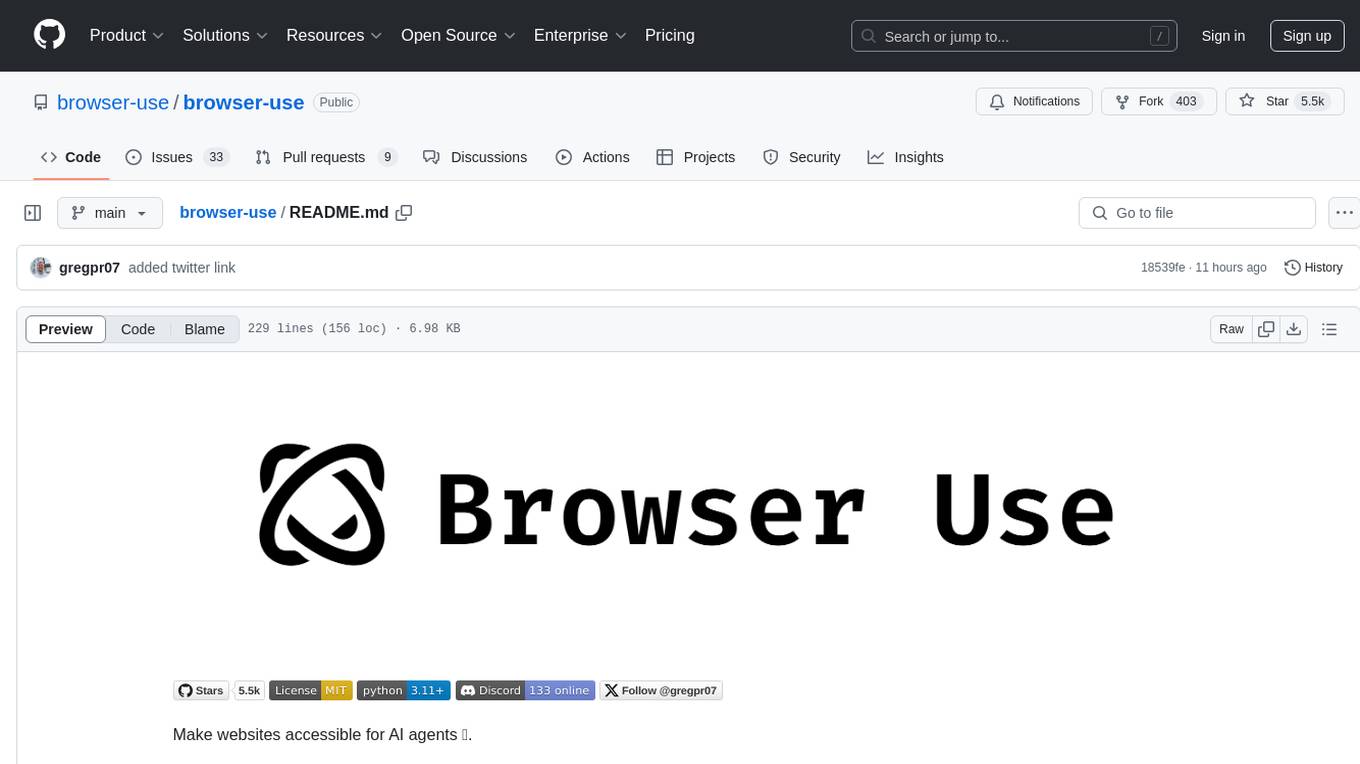
browser-use
Browser Use is a tool designed to make websites accessible for AI agents. It provides an easy way to connect AI agents with the browser, enabling users to perform tasks such as extracting vision and HTML elements, managing multiple tabs, and executing custom actions. The tool supports various language models and allows users to parallelize multiple agents for efficient processing. With features like self-correction and the ability to register custom actions, Browser Use offers a versatile solution for interacting with web content using AI technology.
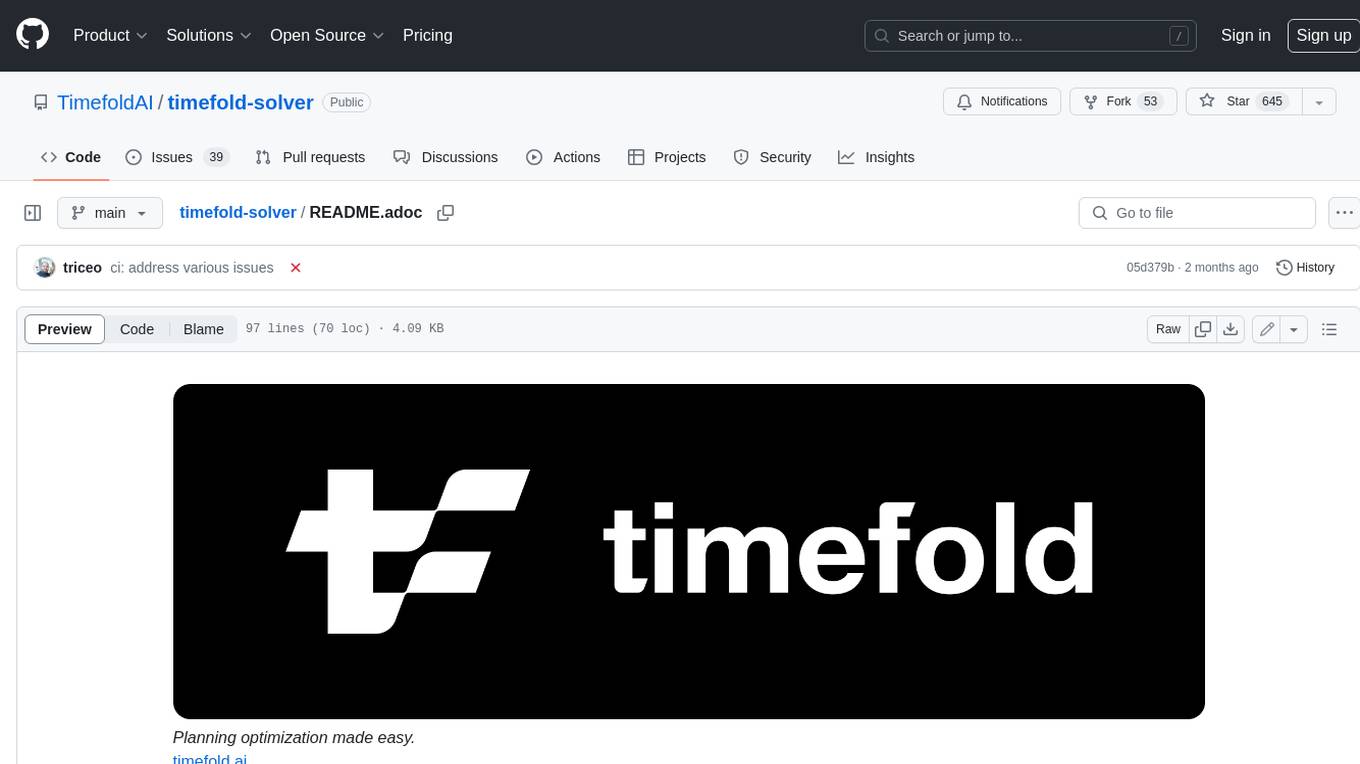
timefold-solver
Timefold Solver is an optimization engine evolved from OptaPlanner. Developed by the original OptaPlanner team, our aim is to free the world of wasteful planning.
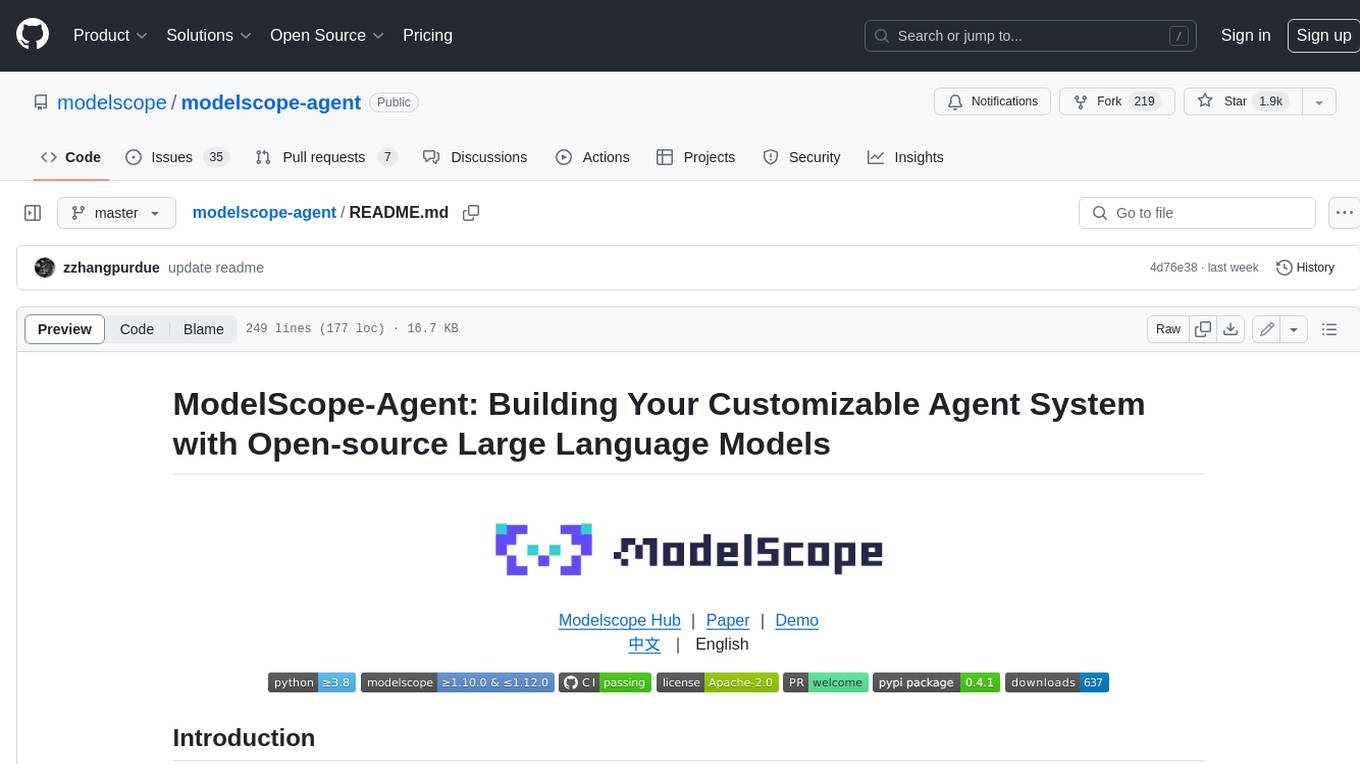
modelscope-agent
ModelScope-Agent is a customizable and scalable Agent framework. A single agent has abilities such as role-playing, LLM calling, tool usage, planning, and memory. It mainly has the following characteristics: - **Simple Agent Implementation Process**: Simply specify the role instruction, LLM name, and tool name list to implement an Agent application. The framework automatically arranges workflows for tool usage, planning, and memory. - **Rich models and tools**: The framework is equipped with rich LLM interfaces, such as Dashscope and Modelscope model interfaces, OpenAI model interfaces, etc. Built in rich tools, such as **code interpreter**, **weather query**, **text to image**, **web browsing**, etc., make it easy to customize exclusive agents. - **Unified interface and high scalability**: The framework has clear tools and LLM registration mechanism, making it convenient for users to expand more diverse Agent applications. - **Low coupling**: Developers can easily use built-in tools, LLM, memory, and other components without the need to bind higher-level agents.
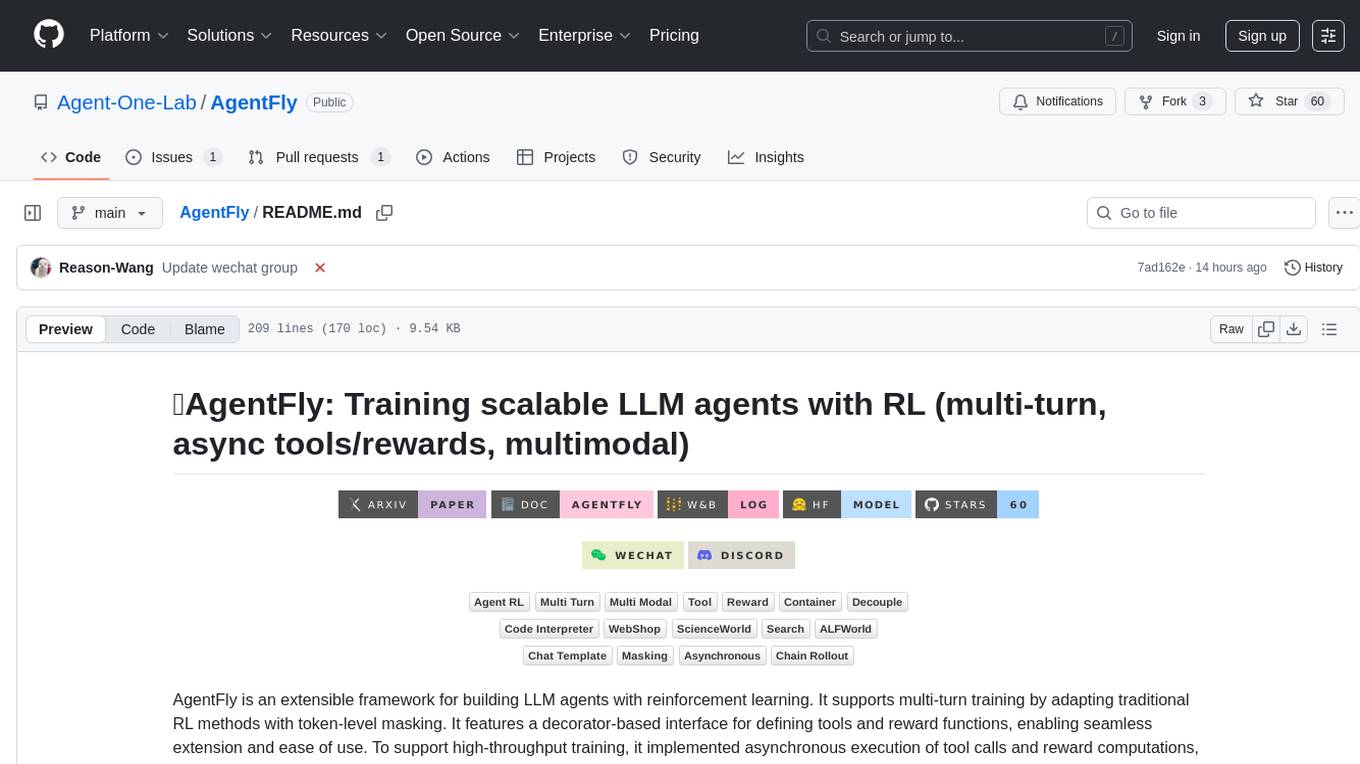
AgentFly
AgentFly is an extensible framework for building LLM agents with reinforcement learning. It supports multi-turn training by adapting traditional RL methods with token-level masking. It features a decorator-based interface for defining tools and reward functions, enabling seamless extension and ease of use. To support high-throughput training, it implemented asynchronous execution of tool calls and reward computations, and designed a centralized resource management system for scalable environment coordination. A suite of prebuilt tools and environments are provided.
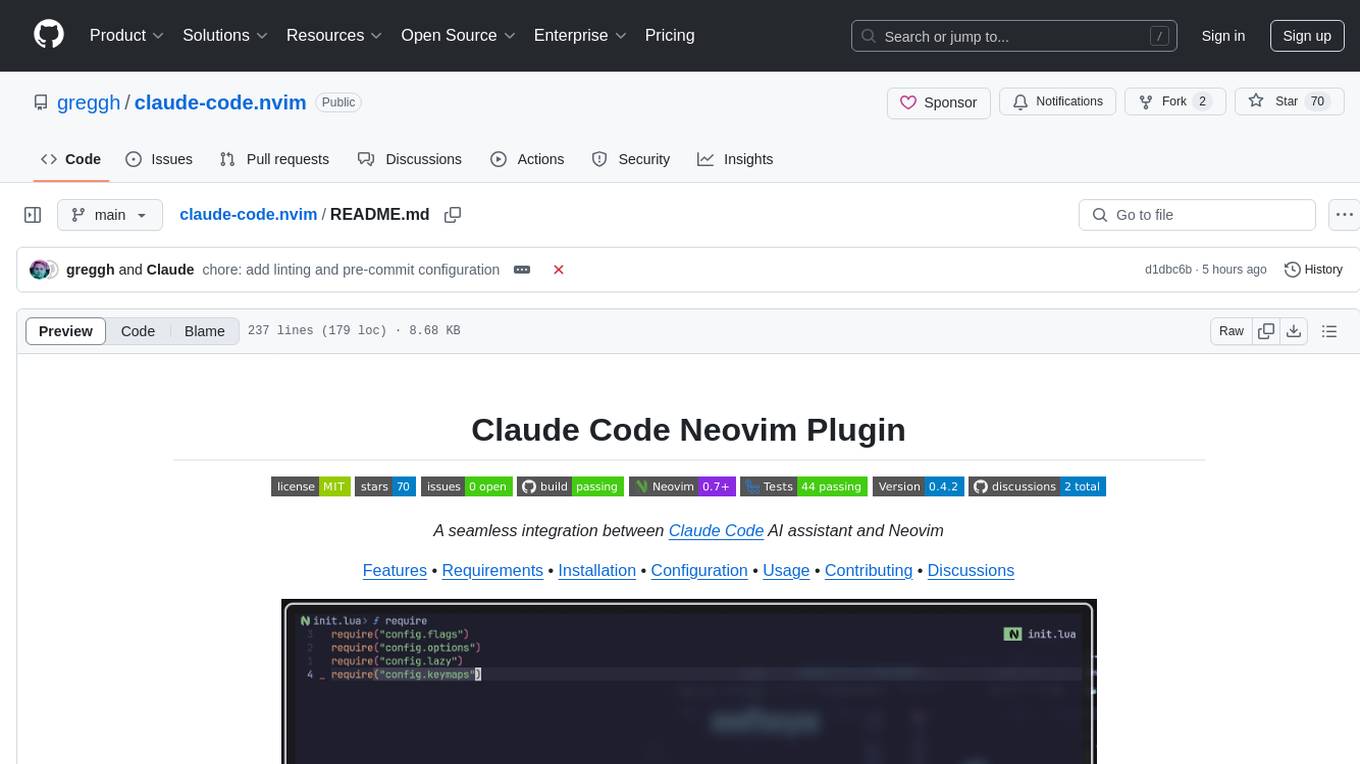
claude-code.nvim
Claude Code Neovim Plugin is a seamless integration between Claude Code AI assistant and Neovim. It allows users to toggle Claude Code in a terminal window with a single key press, automatically detect and reload files modified by Claude Code, provide real-time buffer updates when files are changed externally, offer customizable window position and size, integrate with which-key, use git project root as working directory, maintain a modular code structure, provide type annotations with LuaCATS for better IDE support, offer configuration validation, and include a testing framework for reliability. The plugin creates a terminal buffer running the Claude Code CLI, sets up autocommands to detect file changes on disk, automatically reloads files modified by Claude Code, provides keymaps and commands for toggling the terminal, and detects git repositories to set the working directory to the git root.
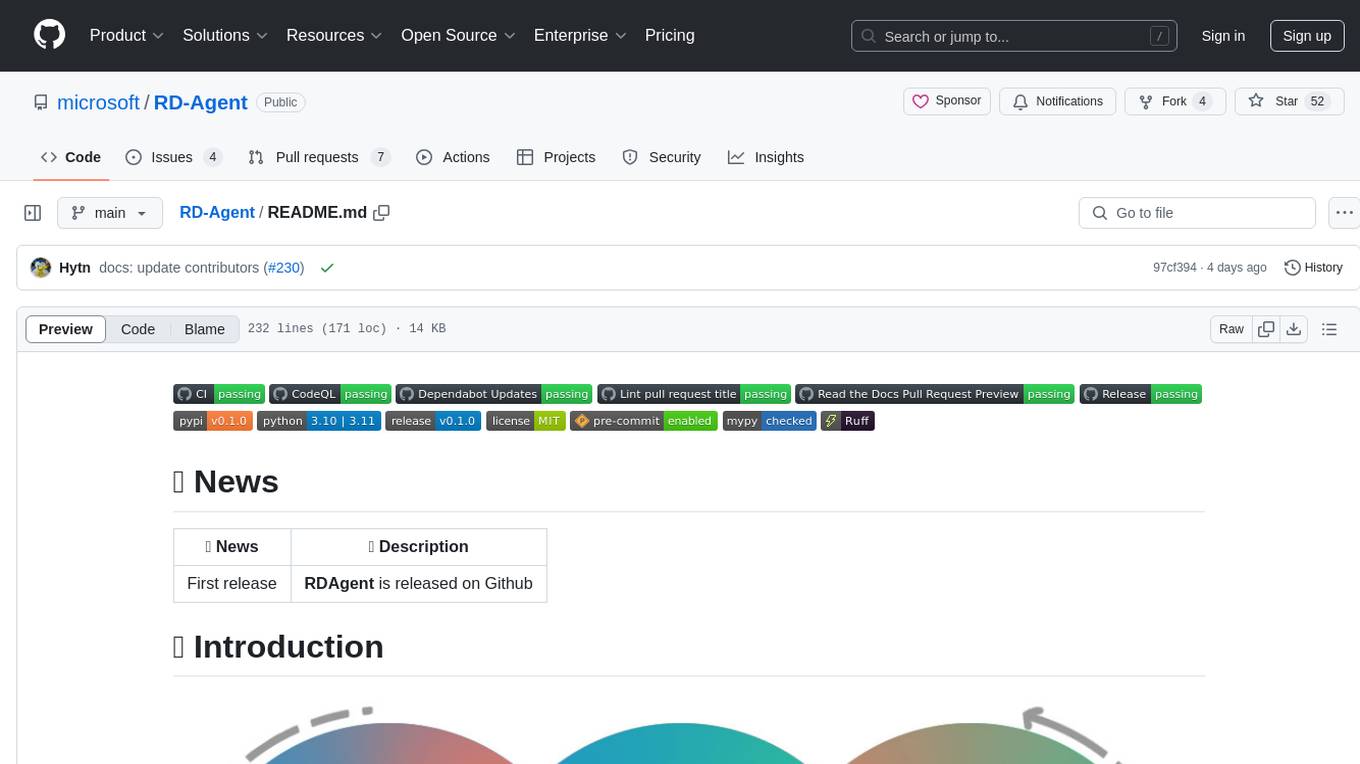
RD-Agent
RD-Agent is a tool designed to automate critical aspects of industrial R&D processes, focusing on data-driven scenarios to streamline model and data development. It aims to propose new ideas ('R') and implement them ('D') automatically, leading to solutions of significant industrial value. The tool supports scenarios like Automated Quantitative Trading, Data Mining Agent, Research Copilot, and more, with a framework to push the boundaries of research in data science. Users can create a Conda environment, install the RDAgent package from PyPI, configure GPT model, and run various applications for tasks like quantitative trading, model evolution, medical prediction, and more. The tool is intended to enhance R&D processes and boost productivity in industrial settings.
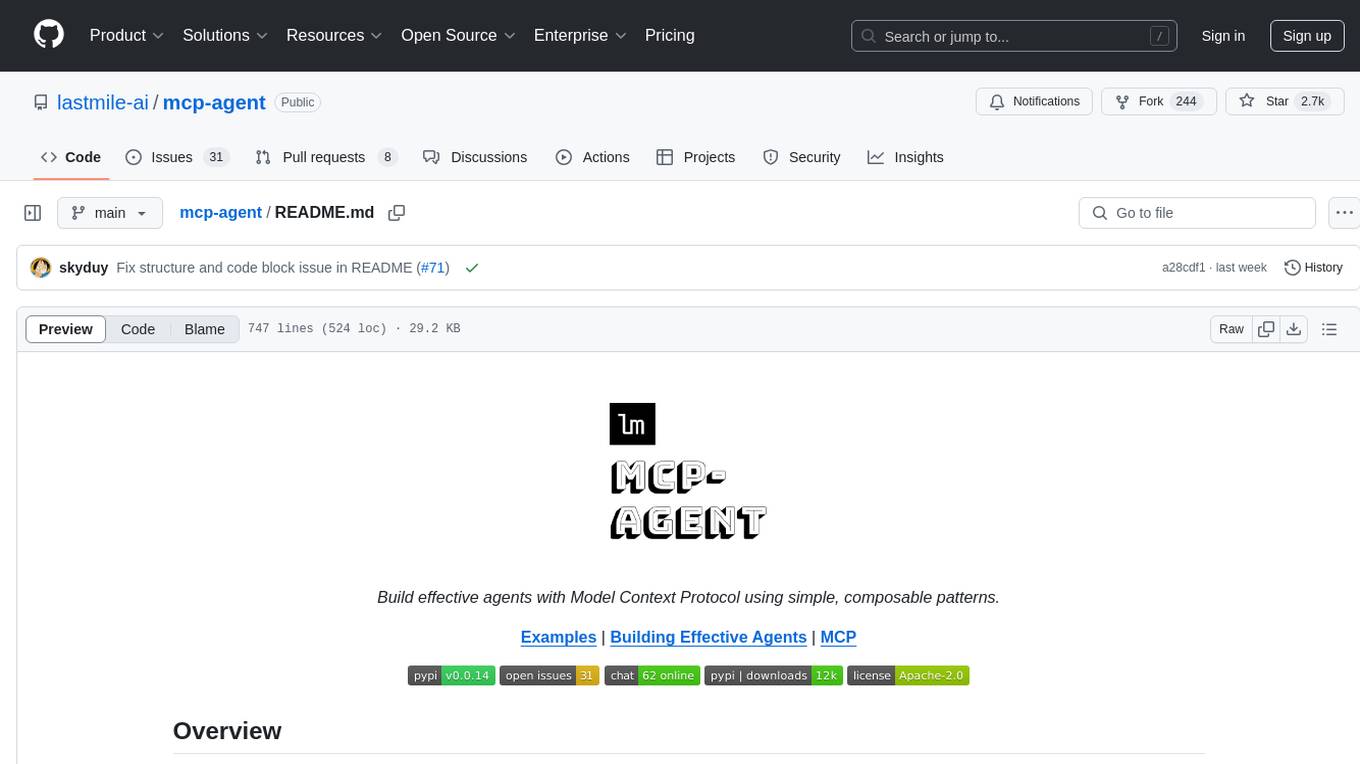
mcp-agent
mcp-agent is a simple, composable framework designed to build agents using the Model Context Protocol. It handles the lifecycle of MCP server connections and implements patterns for building production-ready AI agents in a composable way. The framework also includes OpenAI's Swarm pattern for multi-agent orchestration in a model-agnostic manner, making it the simplest way to build robust agent applications. It is purpose-built for the shared protocol MCP, lightweight, and closer to an agent pattern library than a framework. mcp-agent allows developers to focus on the core business logic of their AI applications by handling mechanics such as server connections, working with LLMs, and supporting external signals like human input.
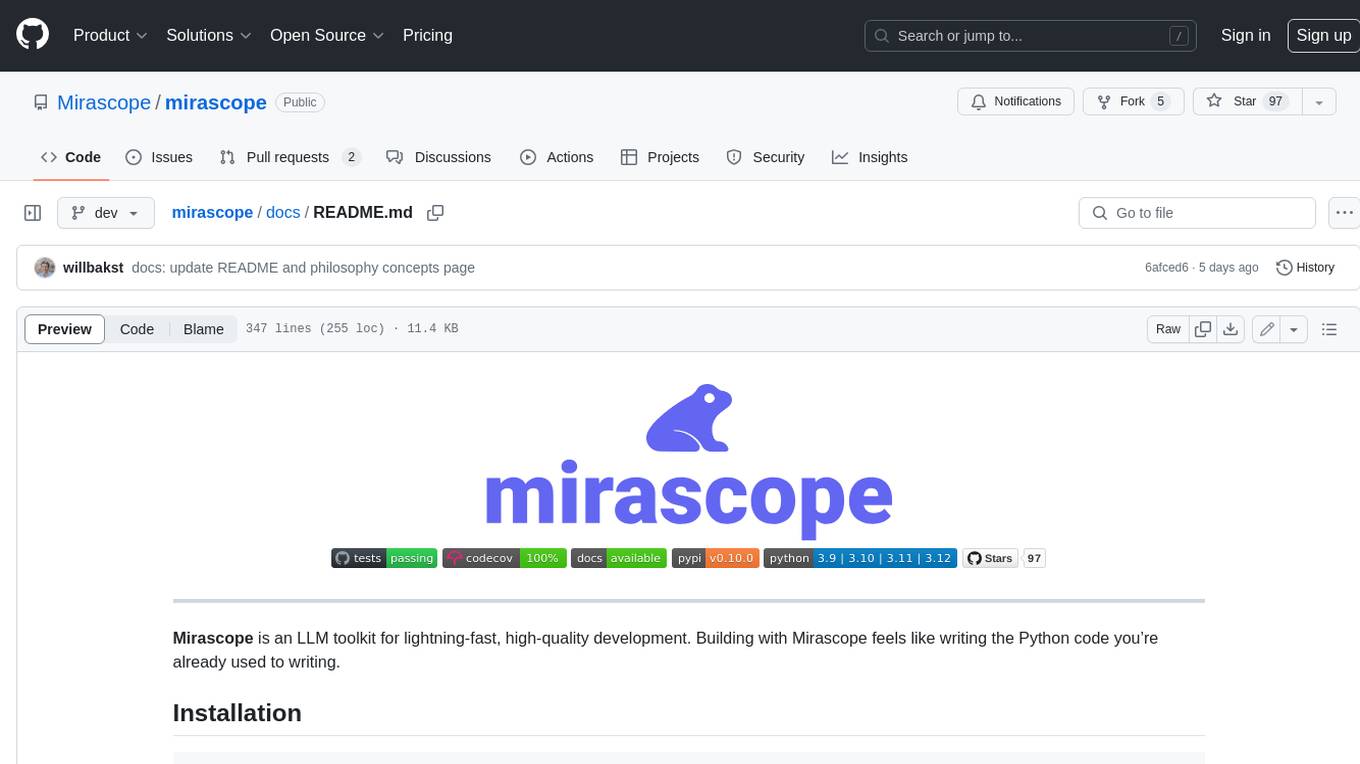
mirascope
Mirascope is an LLM toolkit for lightning-fast, high-quality development. Building with Mirascope feels like writing the Python code you’re already used to writing.
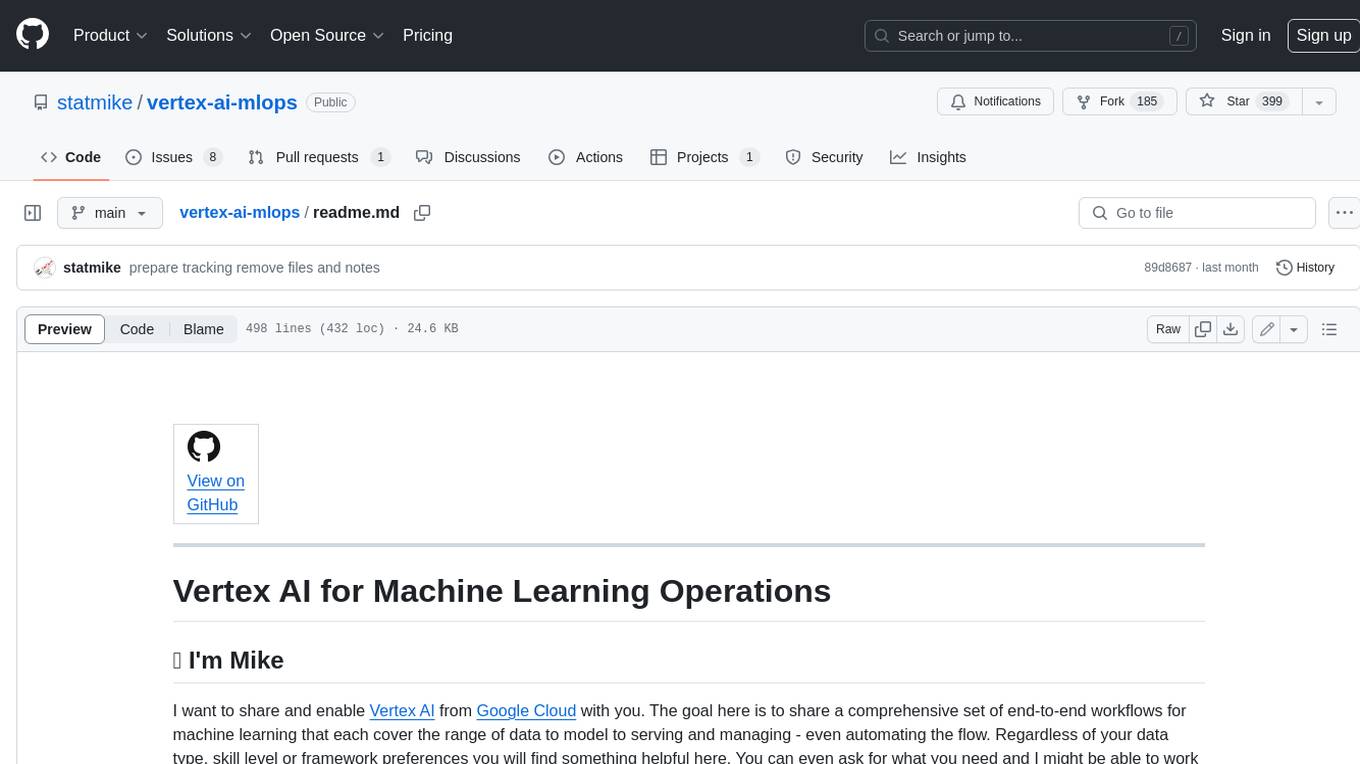
vertex-ai-mlops
Vertex AI is a platform for end-to-end model development. It consist of core components that make the processes of MLOps possible for design patterns of all types.
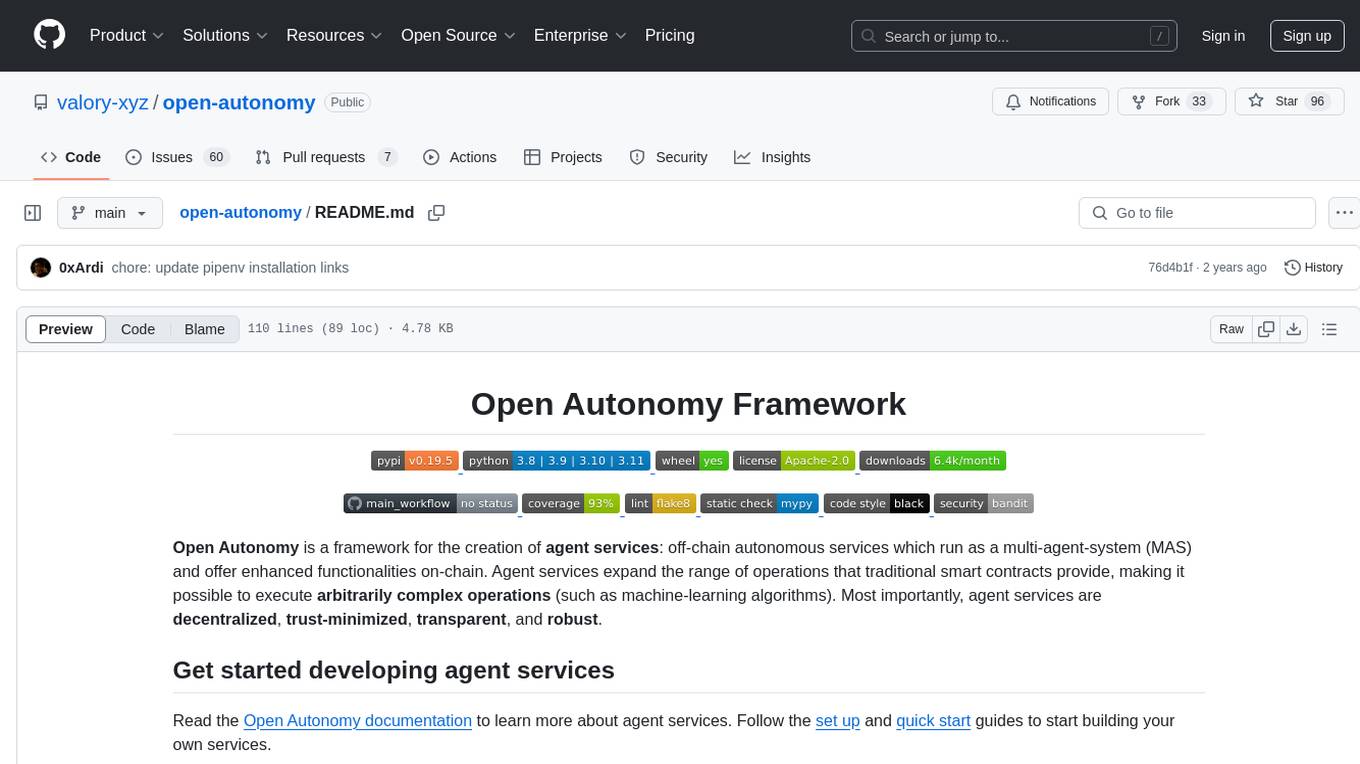
open-autonomy
Open Autonomy is a framework for creating agent services that run as a multi-agent-system and offer enhanced functionalities on-chain. It enables executing complex operations like machine-learning algorithms in a decentralized, trust-minimized, transparent, and robust manner.
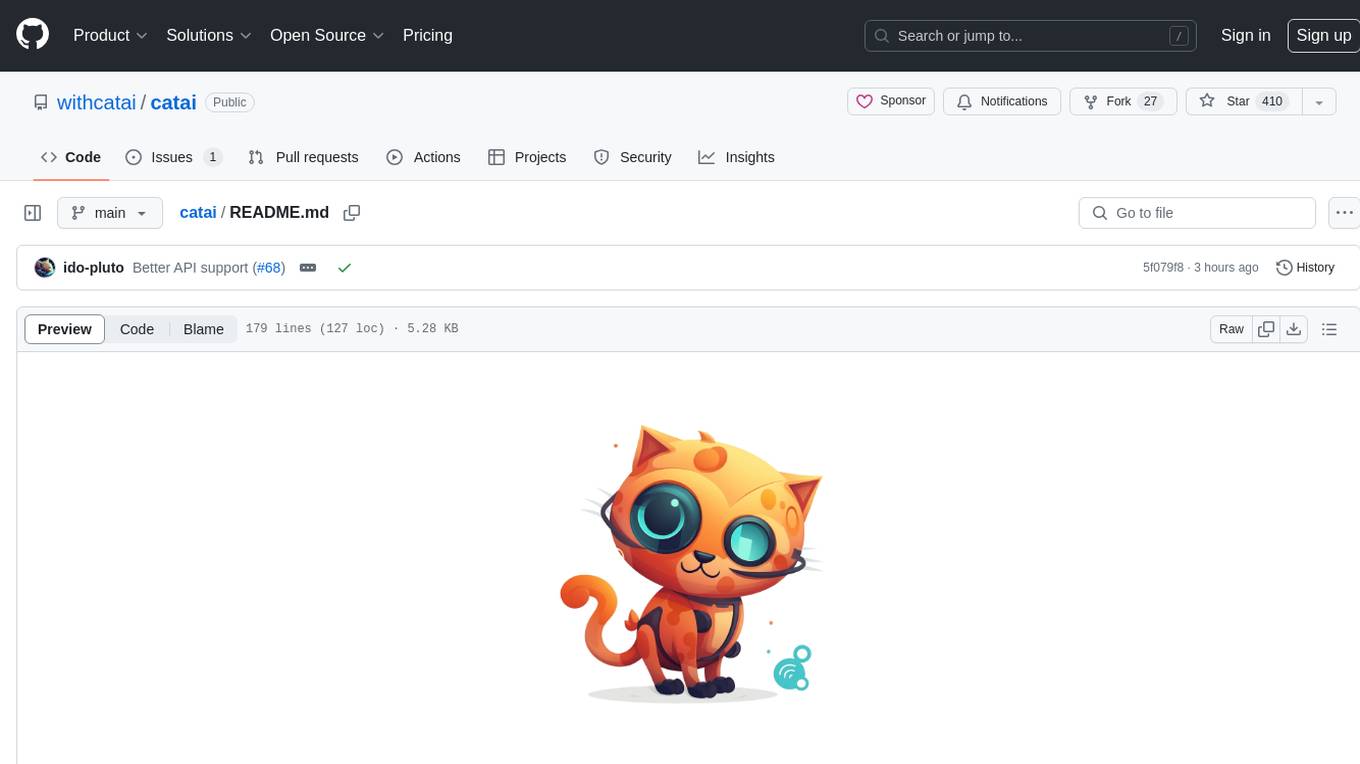
catai
CatAI is a tool that allows users to run GGUF models on their computer with a chat UI. It serves as a local AI assistant inspired by Node-Llama-Cpp and Llama.cpp. The tool provides features such as auto-detecting programming language, showing original messages by clicking on user icons, real-time text streaming, and fast model downloads. Users can interact with the tool through a CLI that supports commands for installing, listing, setting, serving, updating, and removing models. CatAI is cross-platform and supports Windows, Linux, and Mac. It utilizes node-llama-cpp and offers a simple API for asking model questions. Additionally, developers can integrate the tool with node-llama-cpp@beta for model management and chatting. The configuration can be edited via the web UI, and contributions to the project are welcome. The tool is licensed under Llama.cpp's license.
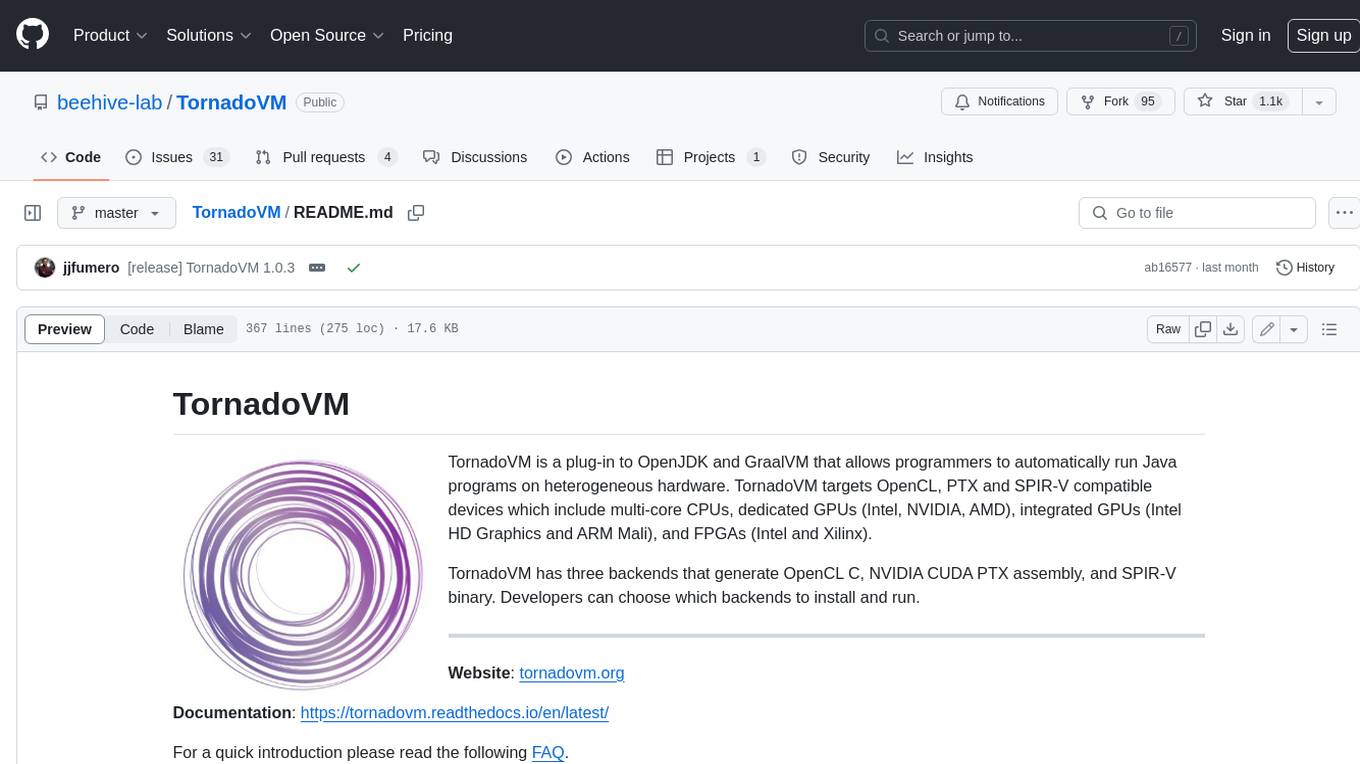
TornadoVM
TornadoVM is a plug-in to OpenJDK and GraalVM that allows programmers to automatically run Java programs on heterogeneous hardware. TornadoVM targets OpenCL, PTX and SPIR-V compatible devices which include multi-core CPUs, dedicated GPUs (Intel, NVIDIA, AMD), integrated GPUs (Intel HD Graphics and ARM Mali), and FPGAs (Intel and Xilinx).
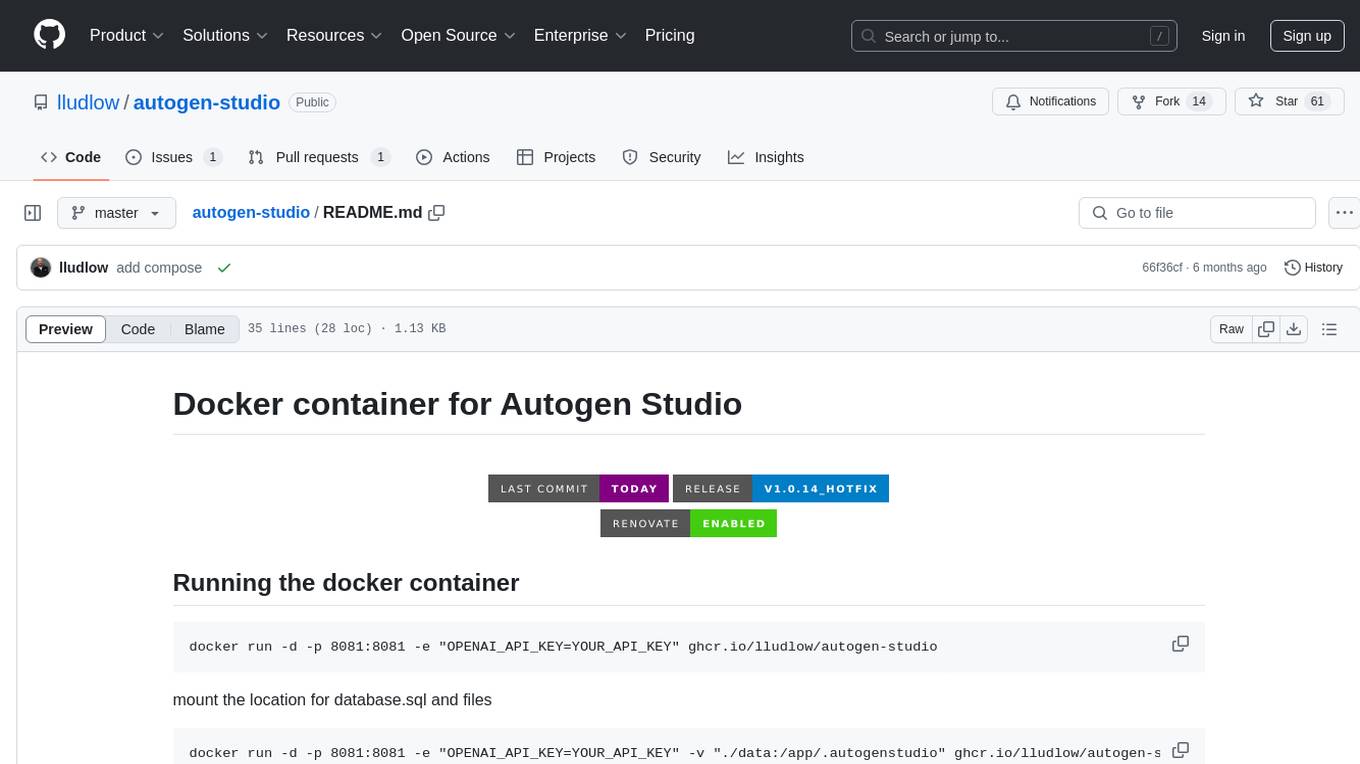
autogen-studio
Autogen Studio is a Docker container that provides a platform for running automated tasks using OpenAI API. It allows users to easily set up and manage a workspace for generating content and performing various tasks. The container can be run standalone or using Docker Compose, with options to mount data volumes and configure environment variables. Autogen Studio simplifies the process of leveraging AI capabilities for automating tasks and content generation.
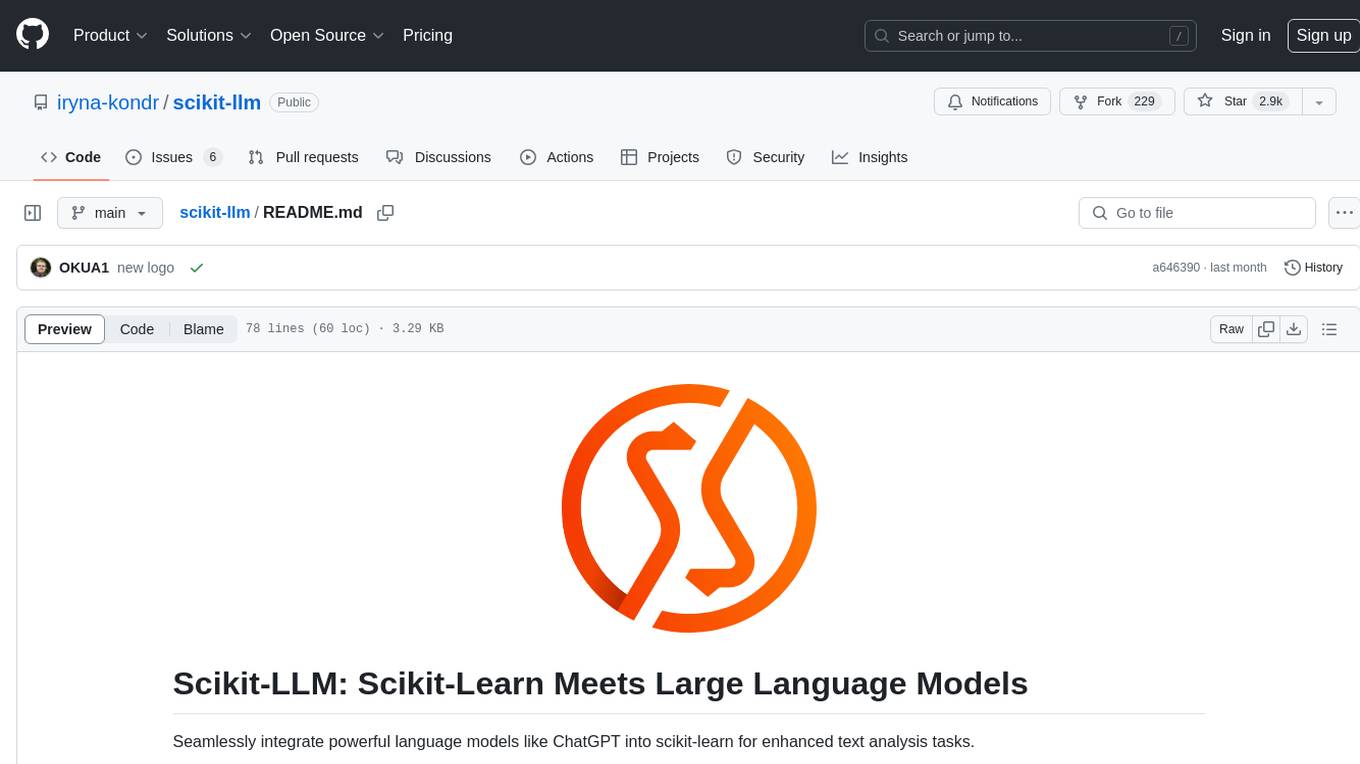
scikit-llm
Scikit-LLM is a tool that seamlessly integrates powerful language models like ChatGPT into scikit-learn for enhanced text analysis tasks. It allows users to leverage large language models for various text analysis applications within the familiar scikit-learn framework. The tool simplifies the process of incorporating advanced language processing capabilities into machine learning pipelines, enabling users to benefit from the latest advancements in natural language processing.
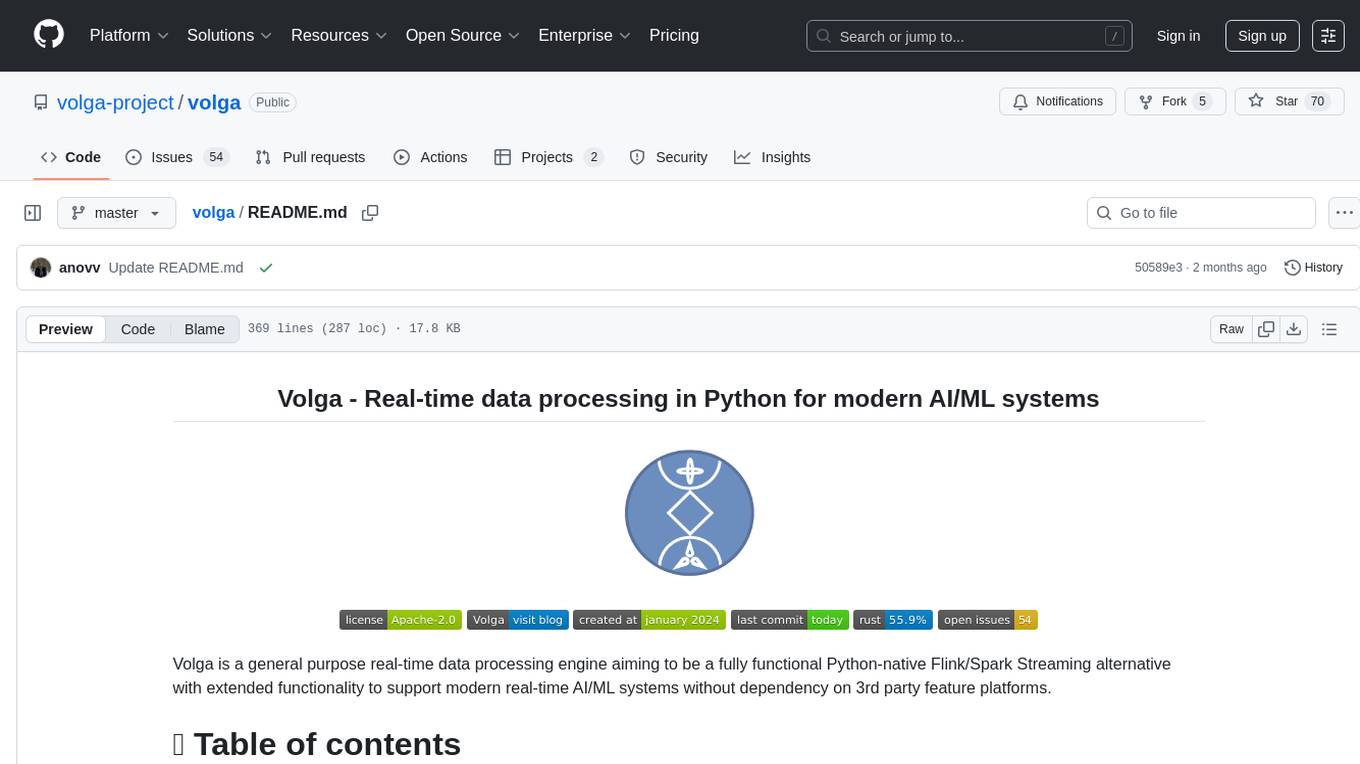
volga
Volga is a general purpose real-time data processing engine in Python for modern AI/ML systems. It aims to be a Python-native alternative to Flink/Spark Streaming with extended functionality for real-time AI/ML workloads. It provides a hybrid push+pull architecture, Entity API for defining data entities and feature pipelines, DataStream API for general data processing, and customizable data connectors. Volga can run on a laptop or a distributed cluster, making it suitable for building custom real-time AI/ML feature platforms or general data pipelines without relying on third-party platforms.
For similar tasks

timefold-solver
Timefold Solver is an optimization engine evolved from OptaPlanner. Developed by the original OptaPlanner team, our aim is to free the world of wasteful planning.

incubator-kie-optaplanner
A fast, easy-to-use, open source AI constraint solver for software developers. OptaPlanner is a powerful tool that helps developers solve complex optimization problems by providing a constraint satisfaction solver. It allows users to model and solve planning and scheduling problems efficiently, improving decision-making processes and resource allocation. With OptaPlanner, developers can easily integrate optimization capabilities into their applications, leading to better performance and cost-effectiveness.
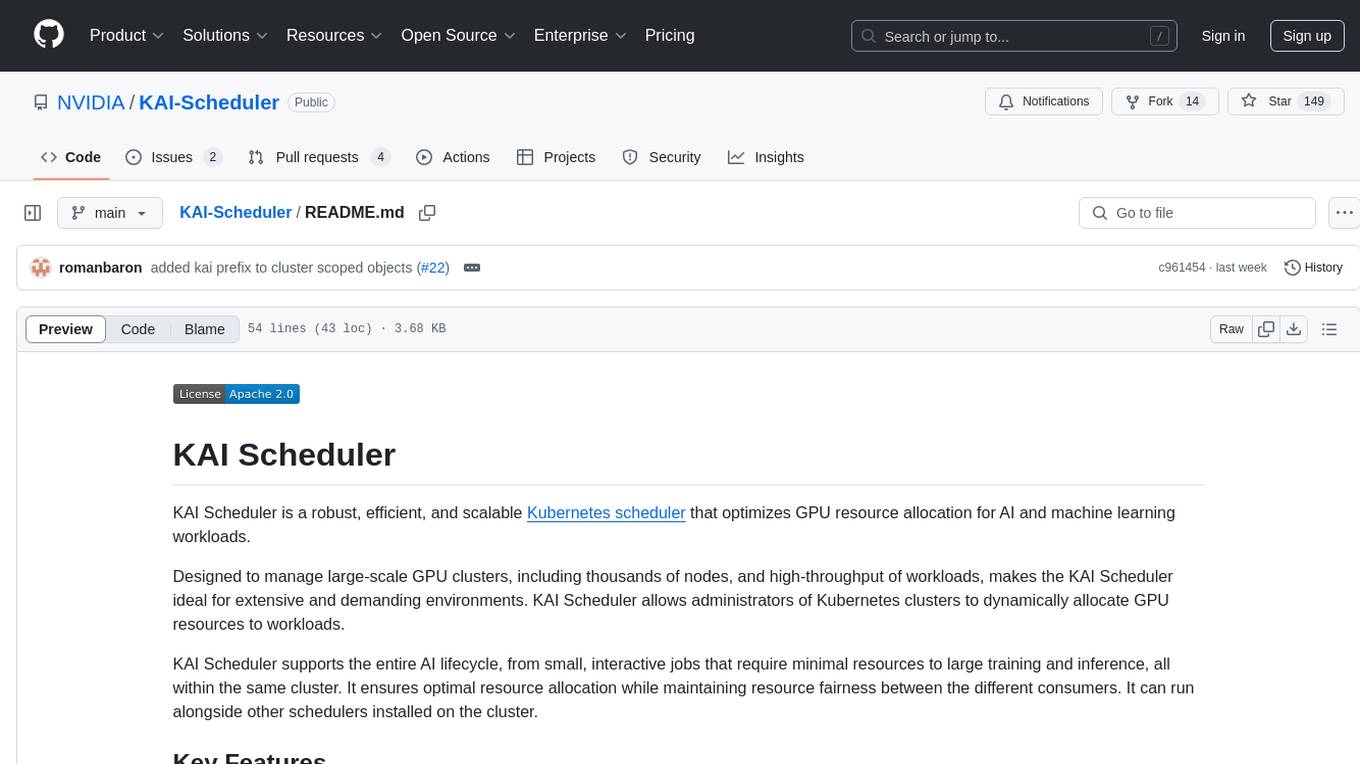
KAI-Scheduler
KAI Scheduler is a robust, efficient, and scalable Kubernetes scheduler optimized for GPU resource allocation in AI and machine learning workloads. It supports batch scheduling, bin packing, spread scheduling, workload priority, hierarchical queues, resource distribution, fairness policies, workload consolidation, elastic workloads, dynamic resource allocation, GPU sharing, and works in both cloud and on-premise environments.
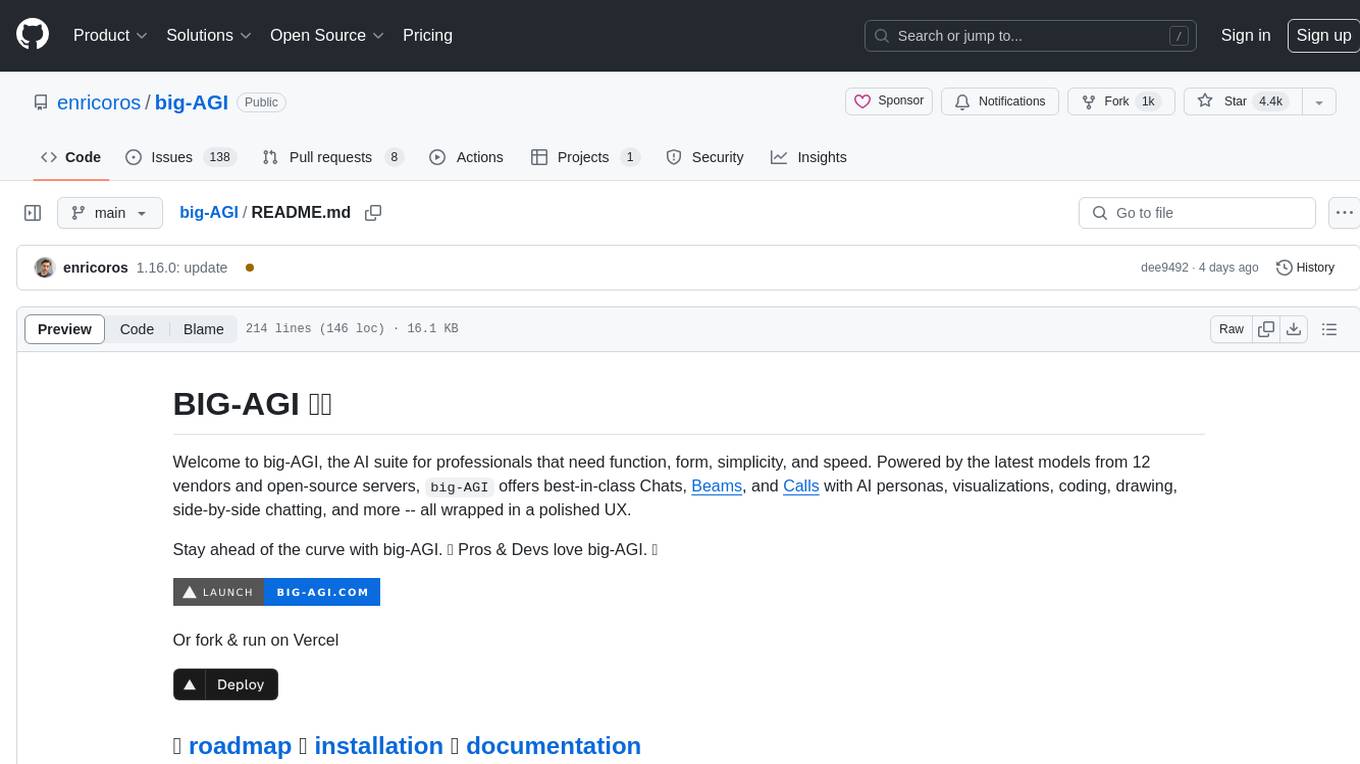
big-AGI
big-AGI is an AI suite designed for professionals seeking function, form, simplicity, and speed. It offers best-in-class Chats, Beams, and Calls with AI personas, visualizations, coding, drawing, side-by-side chatting, and more, all wrapped in a polished UX. The tool is powered by the latest models from 12 vendors and open-source servers, providing users with advanced AI capabilities and a seamless user experience. With continuous updates and enhancements, big-AGI aims to stay ahead of the curve in the AI landscape, catering to the needs of both developers and AI enthusiasts.
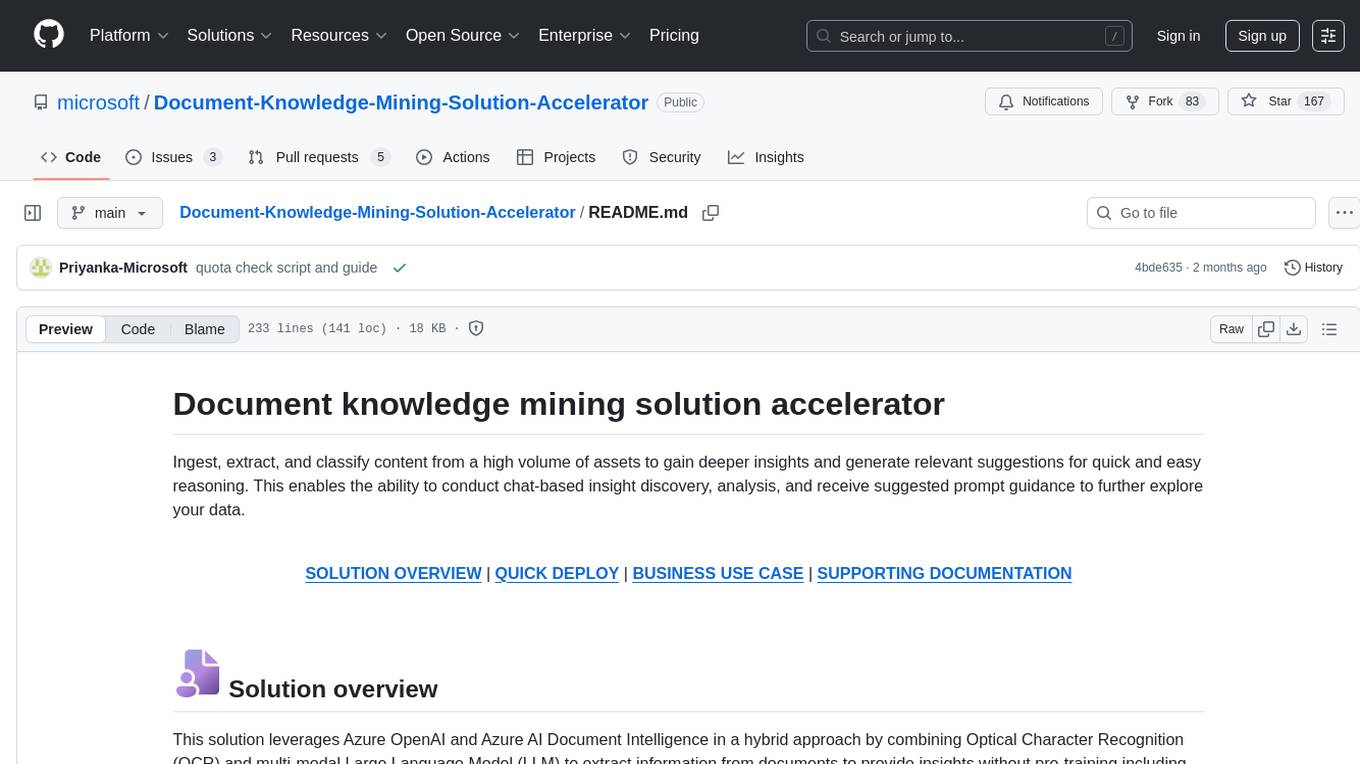
Document-Knowledge-Mining-Solution-Accelerator
The Document Knowledge Mining Solution Accelerator leverages Azure OpenAI and Azure AI Document Intelligence to ingest, extract, and classify content from various assets, enabling chat-based insight discovery, analysis, and prompt guidance. It uses OCR and multi-modal LLM to extract information from documents like text, handwritten text, charts, graphs, tables, and form fields. Users can customize the technical architecture and data processing workflow. Key features include ingesting and extracting real-world entities, chat-based insights discovery, text and document data analysis, prompt suggestion guidance, and multi-modal information processing.
For similar jobs

Azure-Analytics-and-AI-Engagement
The Azure-Analytics-and-AI-Engagement repository provides packaged Industry Scenario DREAM Demos with ARM templates (Containing a demo web application, Power BI reports, Synapse resources, AML Notebooks etc.) that can be deployed in a customer’s subscription using the CAPE tool within a matter of few hours. Partners can also deploy DREAM Demos in their own subscriptions using DPoC.
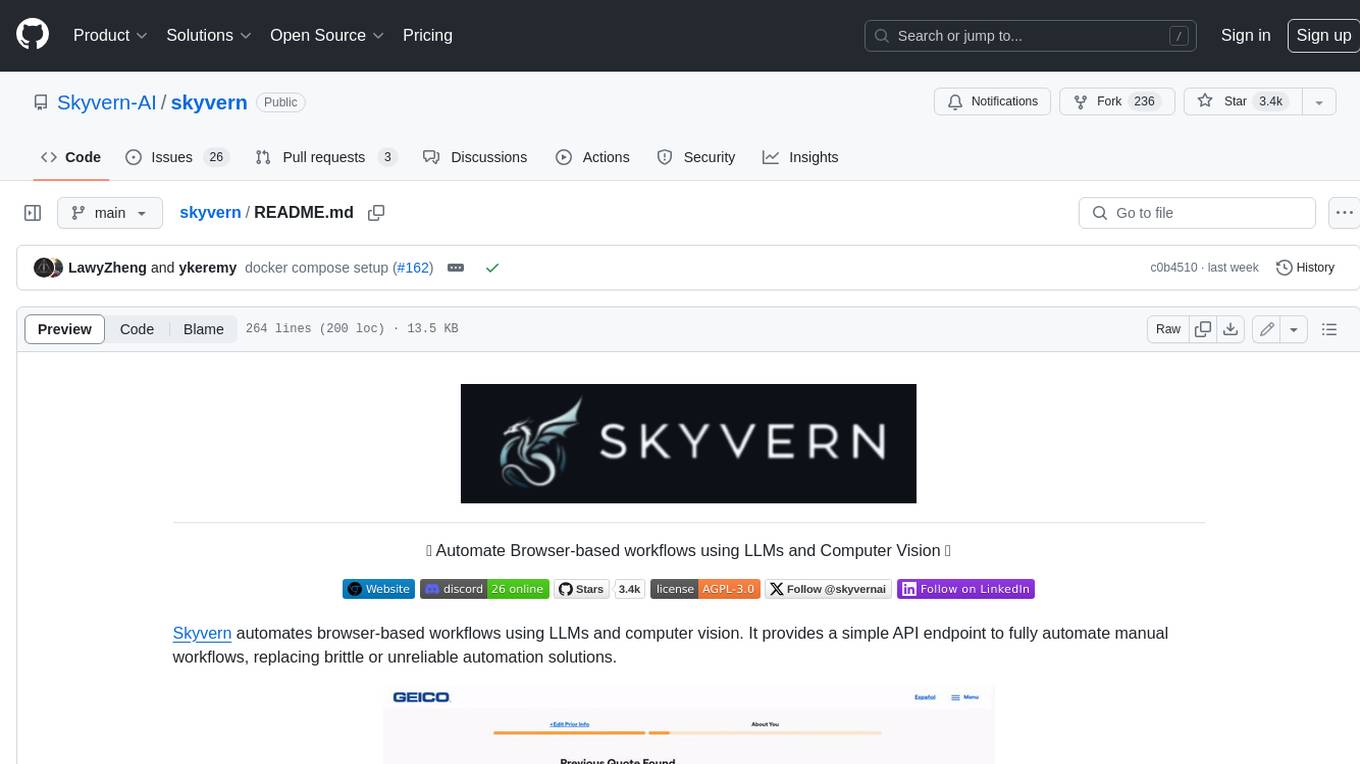
skyvern
Skyvern automates browser-based workflows using LLMs and computer vision. It provides a simple API endpoint to fully automate manual workflows, replacing brittle or unreliable automation solutions. Traditional approaches to browser automations required writing custom scripts for websites, often relying on DOM parsing and XPath-based interactions which would break whenever the website layouts changed. Instead of only relying on code-defined XPath interactions, Skyvern adds computer vision and LLMs to the mix to parse items in the viewport in real-time, create a plan for interaction and interact with them. This approach gives us a few advantages: 1. Skyvern can operate on websites it’s never seen before, as it’s able to map visual elements to actions necessary to complete a workflow, without any customized code 2. Skyvern is resistant to website layout changes, as there are no pre-determined XPaths or other selectors our system is looking for while trying to navigate 3. Skyvern leverages LLMs to reason through interactions to ensure we can cover complex situations. Examples include: 1. If you wanted to get an auto insurance quote from Geico, the answer to a common question “Were you eligible to drive at 18?” could be inferred from the driver receiving their license at age 16 2. If you were doing competitor analysis, it’s understanding that an Arnold Palmer 22 oz can at 7/11 is almost definitely the same product as a 23 oz can at Gopuff (even though the sizes are slightly different, which could be a rounding error!) Want to see examples of Skyvern in action? Jump to #real-world-examples-of- skyvern
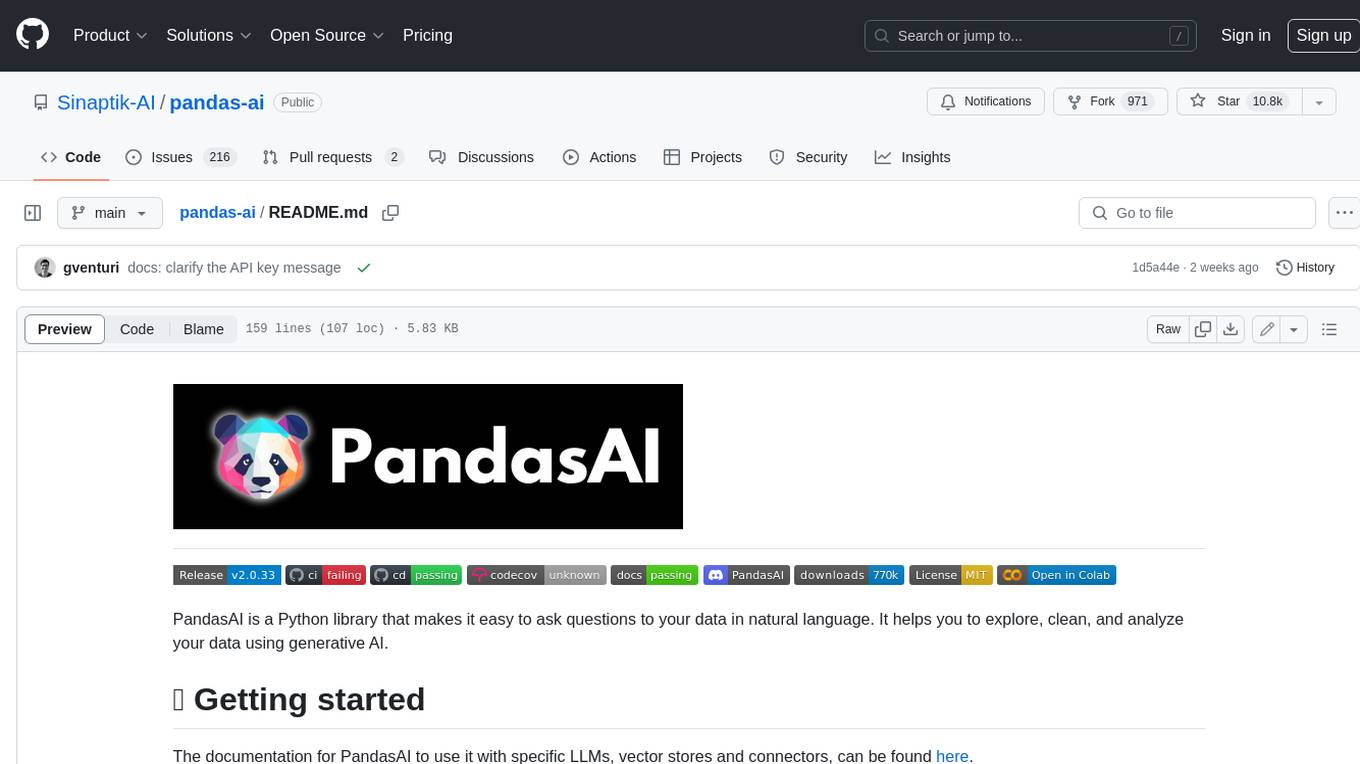
pandas-ai
PandasAI is a Python library that makes it easy to ask questions to your data in natural language. It helps you to explore, clean, and analyze your data using generative AI.
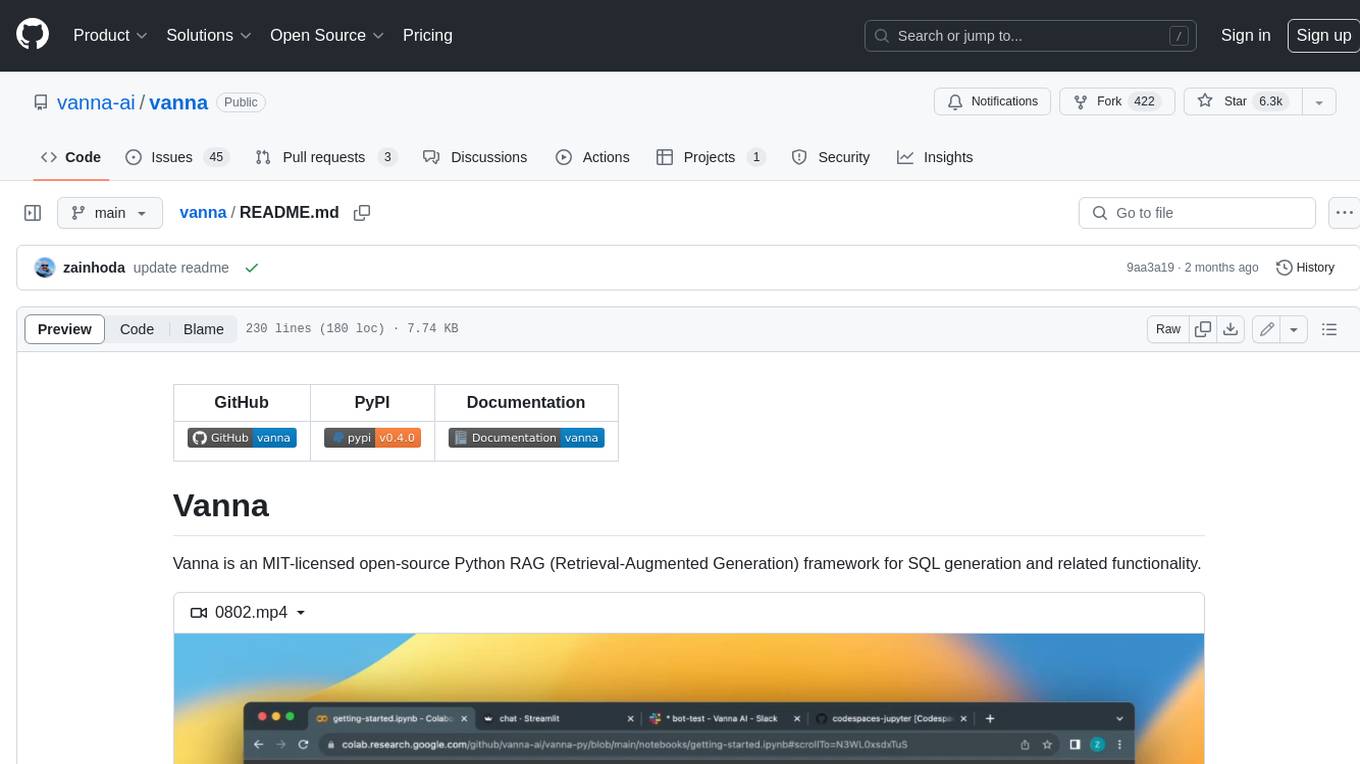
vanna
Vanna is an open-source Python framework for SQL generation and related functionality. It uses Retrieval-Augmented Generation (RAG) to train a model on your data, which can then be used to ask questions and get back SQL queries. Vanna is designed to be portable across different LLMs and vector databases, and it supports any SQL database. It is also secure and private, as your database contents are never sent to the LLM or the vector database.
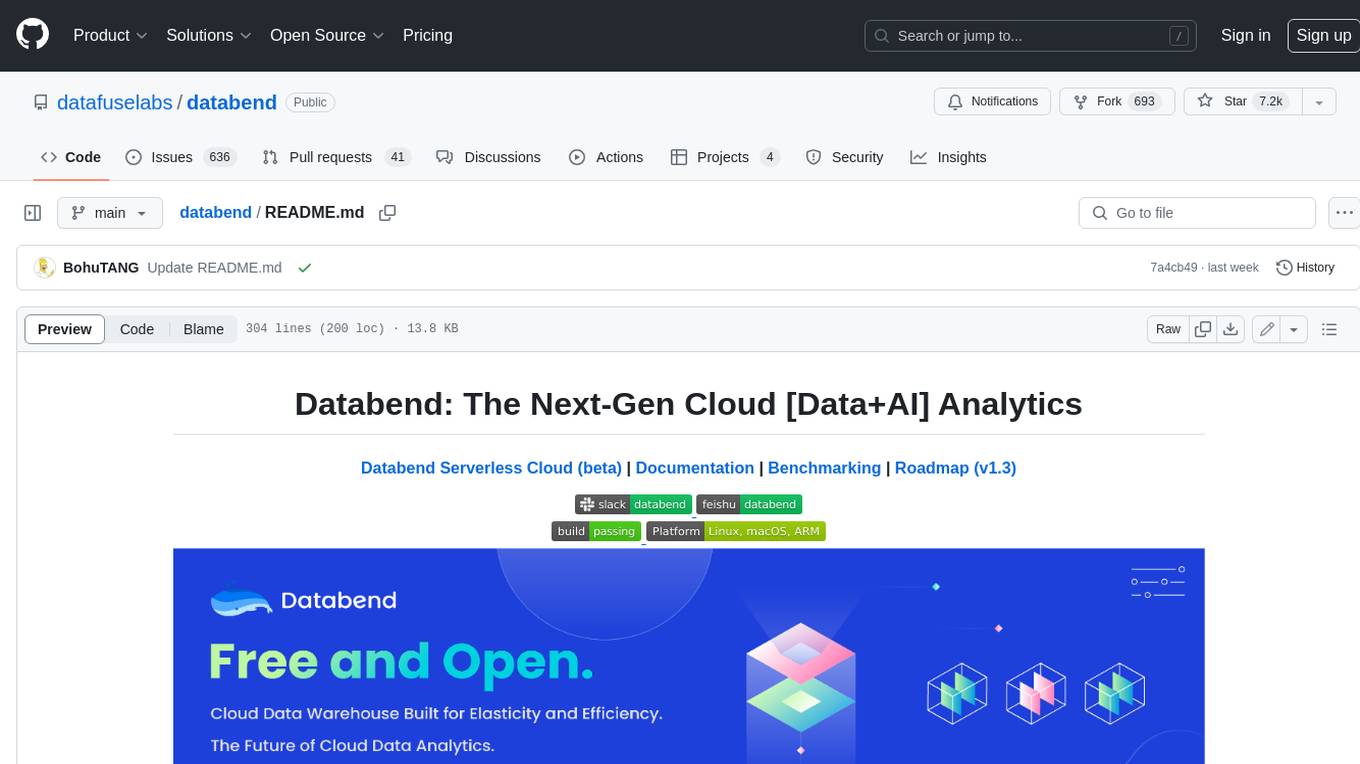
databend
Databend is an open-source cloud data warehouse that serves as a cost-effective alternative to Snowflake. With its focus on fast query execution and data ingestion, it's designed for complex analysis of the world's largest datasets.
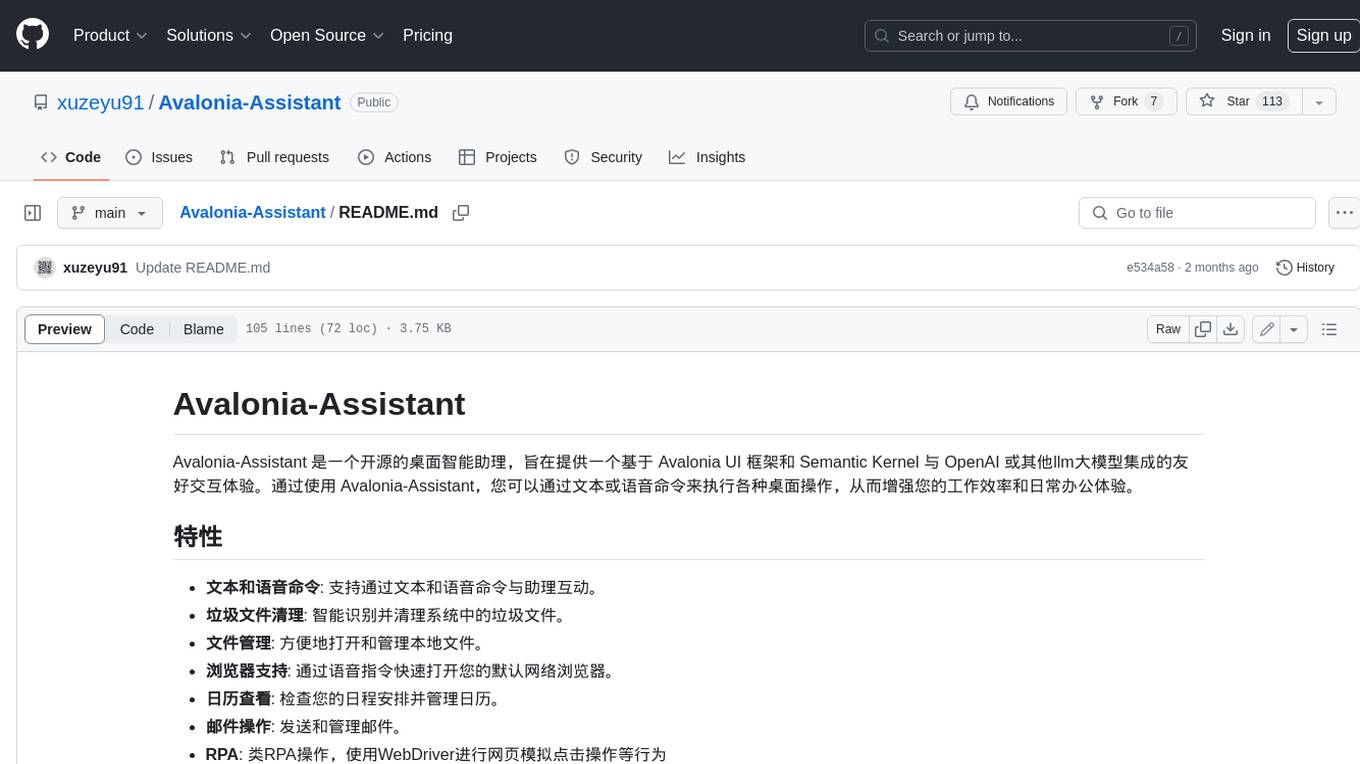
Avalonia-Assistant
Avalonia-Assistant is an open-source desktop intelligent assistant that aims to provide a user-friendly interactive experience based on the Avalonia UI framework and the integration of Semantic Kernel with OpenAI or other large LLM models. By utilizing Avalonia-Assistant, you can perform various desktop operations through text or voice commands, enhancing your productivity and daily office experience.
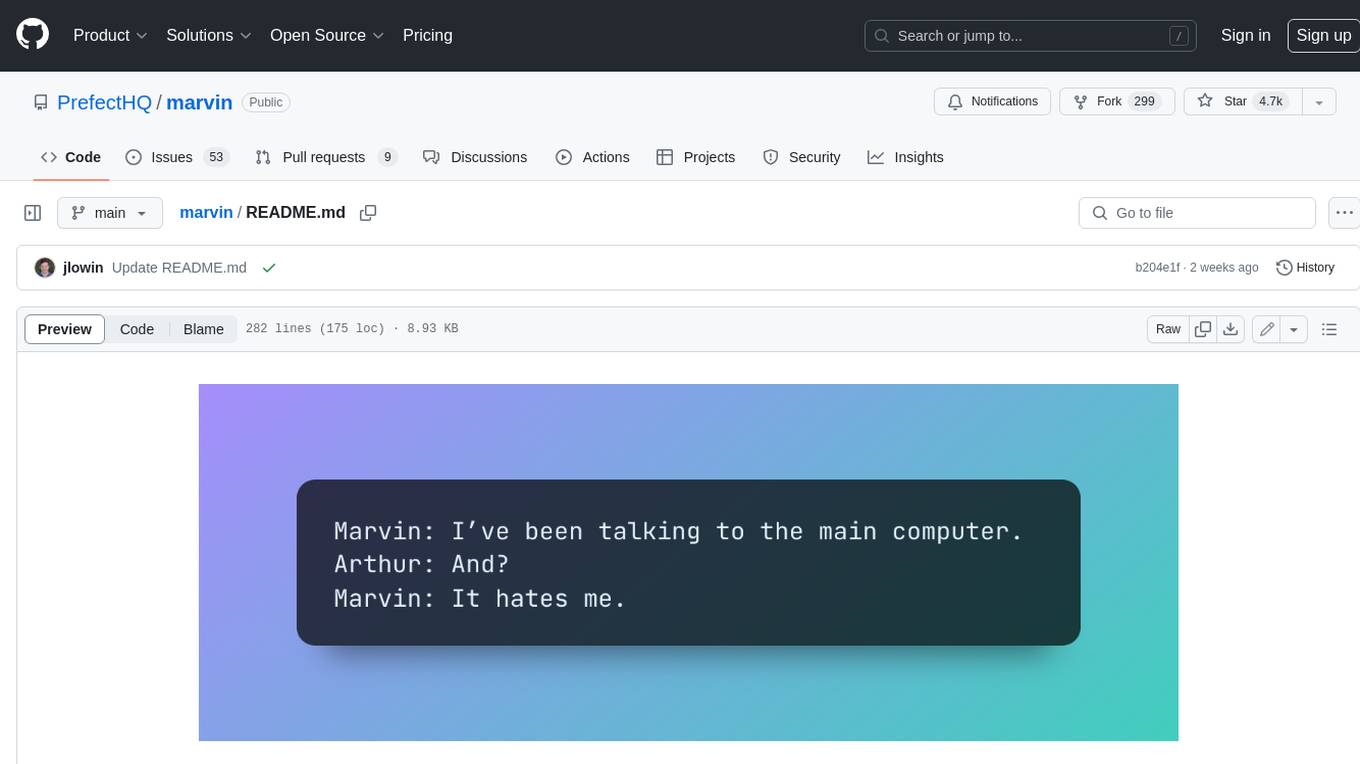
marvin
Marvin is a lightweight AI toolkit for building natural language interfaces that are reliable, scalable, and easy to trust. Each of Marvin's tools is simple and self-documenting, using AI to solve common but complex challenges like entity extraction, classification, and generating synthetic data. Each tool is independent and incrementally adoptable, so you can use them on their own or in combination with any other library. Marvin is also multi-modal, supporting both image and audio generation as well using images as inputs for extraction and classification. Marvin is for developers who care more about _using_ AI than _building_ AI, and we are focused on creating an exceptional developer experience. Marvin users should feel empowered to bring tightly-scoped "AI magic" into any traditional software project with just a few extra lines of code. Marvin aims to merge the best practices for building dependable, observable software with the best practices for building with generative AI into a single, easy-to-use library. It's a serious tool, but we hope you have fun with it. Marvin is open-source, free to use, and made with 💙 by the team at Prefect.
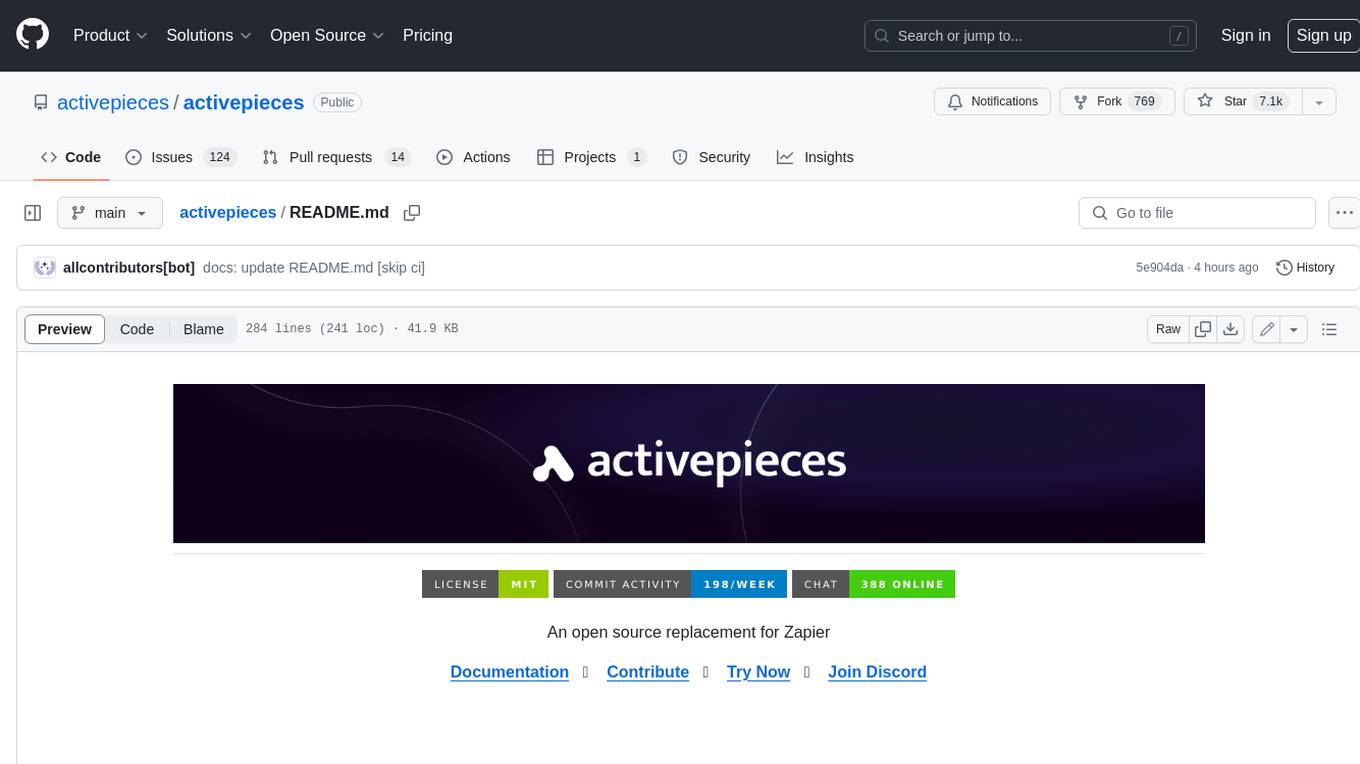
activepieces
Activepieces is an open source replacement for Zapier, designed to be extensible through a type-safe pieces framework written in Typescript. It features a user-friendly Workflow Builder with support for Branches, Loops, and Drag and Drop. Activepieces integrates with Google Sheets, OpenAI, Discord, and RSS, along with 80+ other integrations. The list of supported integrations continues to grow rapidly, thanks to valuable contributions from the community. Activepieces is an open ecosystem; all piece source code is available in the repository, and they are versioned and published directly to npmjs.com upon contributions. If you cannot find a specific piece on the pieces roadmap, please submit a request by visiting the following link: Request Piece Alternatively, if you are a developer, you can quickly build your own piece using our TypeScript framework. For guidance, please refer to the following guide: Contributor's Guide